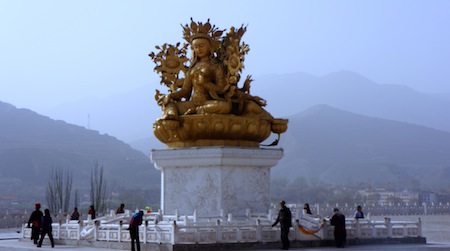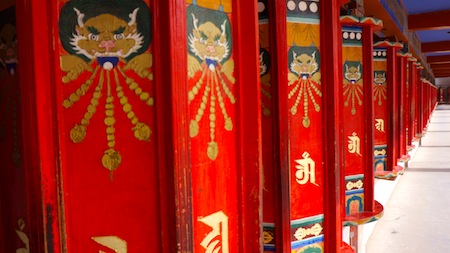


The first thing you notice about Qinghai province is that it’s rather desolate — more Utah than Alaska, and the first thing you notice about Rebkong is that it’s a dusty town far away from even the provincial capital. A world away from the center of Qinghai, itself a world away from Beijing.


I visited Rebkong in April earlier this year with an American friend based at the time in Shanghai, along with Xining (Qinghai’s capital) and other spots in Qinghai province, which lies in the northwest of the People’s Republic of China. Just a couple of hours away from Beijing by air, Qinghai is indeed a world away, lying as it does on the far east of the Tibetan plateau. With just 5.6 million people, the province contains just a handful of China’s trillion-plus population — the only province with fewer people is Tibet proper, with around 3 million.
We went to Qinghai, frankly, because getting PRC approval for the permits and guides to visit Tibet province has become such an incredible hassle since the 2008 Tibetan protests. A kind of ‘Tibet without Tibet.’ But that was probably too twee a slogan, because Qinghai — known historically to Tibetans as Amdo — is as much Tibetan as what lies within the PRC boundaries of the Tibetan ‘autonomous region.’
The region (Amdo or Qinghai, as you like) has been under Chinese control since it was secured by the Qing dynasty in 1724. It’s home to several important Tibetan Buddhist monasteries, including Kumbum monastery (སྐུ་འབུམ་བྱམས་པ་གླིང།, or ‘Ta’er si’ in Mandarin Chinese, 塔尔寺), founded in 1577 on the site of the birthplace of Tsongkhapa, an important figure in the development of Buddhism and the founder of the Gelug (‘yellow-hat’) school of Buddhism — its importance to Tibetan buddhism is second only to Lhasa, Tibet’s capital. Indeed, what we know as ‘Tibet’ today is really just the western part of the historic Tibetan empire, which included not just Amdo, but Kham, which is now the western part of Sichuan province in the PRC. So we were delighted to see a corner of greater Tibet not already fawned over by Richard Gere and so many others.
Xining itself is a mix of Muslims (Hui Chinese), Tibetans and Han Chinese, but outside the capital, Qinghai is indisputably Tibetan, and it’s the birthplace of Tenzin Gyatso, the 14th Dalai Lama.
After a night in Xining quaffing barley wine at the local Tibetan bar, we found a local guide who agreed to show us around for the next couple of days, beyond just a quick trip to Kumbum, but a true journey into the Tibetan hinterland. We started our days with tsampa, a high-power concoction of yak butter and barley flour (it reminded me of a buttery version of the energy gels you eat during marathons), gorged ourselves on momo (yak-meat dumplings) and snacked on fresh yak-milk yogurt in between visiting monasteries, such as Rgolung (Youning si’ in Chinese), which nestles upon a handful of ledges in the cliffs of eastern Qinghai province.
As it so happens, our young, kind guide was from Rebkong, so we spent a night there, and we saw the monastery, Rongwo (pictured above, center and bottom), where he studied as a child and young adult, and we saw the square just outside, Dolma Square (pictured above, top).
That square has become a center of the latest Tibetan protest against the governing Chinese regime when 18-year-old Kalsang Jinpa lit himself on fire [graphic photos] there, one of six Tibetans in the past week to die in a wave of self-immolations in protest of Chinese rule. The situation in Rebkong is becoming tense, according to reports [graphic photos], with 20-year old Nyingchag Bum self-immolating Monday: Continue reading Amid the CCP handover of power to Xi Jinping, ethnic Tibetan issue remains a thorny problem →




